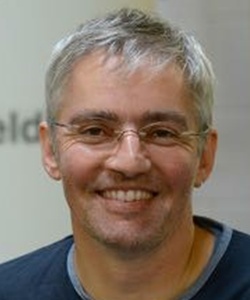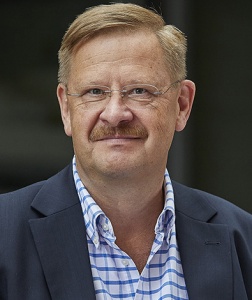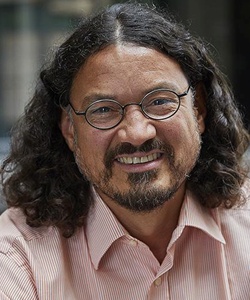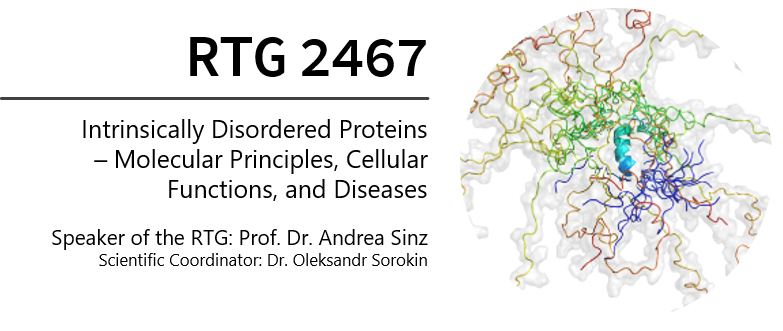
studied Chemistry at the Technical University in Munich, Germany, where he also obtained his PhD in Organic Chemistry. After a postdoc at Oxford University, UK, from 1994 to 1996 with Chris Dobson in the field of protein folding, he moved to the University of Bayreuth, Germany, conducting further research in NMR spectroscopy, first as a scientific assistant, then as a senior lecturer. Since 2004 he is Full Professor of Biophysics and Medical Physics at the Martin Luther University Halle-Wittenberg (MLU). His current interests encompass protein folding and dynamics.

Stephan M. Fellerwas trained in Biology and conducted his diploma research at the University of Heidelberg, Germany, working on the heart hormone ANP. He then moved to The Rockefeller University, New York City, NY, USA, for his PhD research in Cell Biology and Biochemistry (degree awarded in 1994) where he studied (proto-)oncogenes and protein-protein interactions. Returning to Germany in 1995, after a year of postdoc at Rockefeller, he started his own independent junior research group in the same research area at the University of Würzburg, Germany, before moving his laboratory in 2001 to the Sir David Weatherall Institute of Molecular Medicine in Oxford, UK as a principal investigator, Oxford University faculty member and from 2009 as a member of senior common room at Corpus Christi College. In 2013, he joined the Medical Faculty of the MLU as Professor of Tumor Biology. His current research interests include the dynamic architectures and roles of IDPs in signaling pathway cross-talk as well as cancer drug combination therapy. He is also an advocate for preventive medicine and academic international exchange.

studied for a BSc in Physics at the University of Durham, UK, from
1988 to 1983, before obtaining a DPhil in Molecular Biophysics from the
University of Oxford, UK, in 1986. From 1987-1991, he was a postdoctoral
fellow at the Max Planck Institute for Biochemistry in Martinsried,
Germany. He then moved to the Center of Structural Biochemistry at
Karolinska Institute, Stockholm, Sweden, where he became an Assistant
Professor in 1992. He then had a joint appointment as a senior research
fellow at AKZO Organon, Netherlands and the Max Planck Institute for
Biochemistry in Martinsried. In 1995, he started to work as a senior
research fellow at the Department of Clinical Chemistry of the Ludwig
Maximilians University in Munich, Germany. In 1996 he became the head of
X-ray crystallography at the Institute of Pharmaceutical Chemistry,
University of Marburg, Germany, before accepting a professorship in
Physical Biotechnology at the MLU in 2002. He is director of research
center ZIK HALOmem at the MLU.
Project within the RTG
Probing the structural and cellular hub function of the intrinsically disordered Gab1 protein
The IDP Gab1 binds several important signaling proteins via its long, disordered tail, including the tyrosine kinase c-Met, the lipid kinase PI3K and the protein phosphatase SHP2, as well as various adaptor proteins (Grb2, Crkl, Nck1) that recruit additional enzymes (Gruber et al., 2022; Wörle, Daly, & Brummer, 2009; Sakkab et al., 2000). Gab1 thus acts as an intracellular hub, providing opportunities for extensive signaling pathway cross-talk (Lewitzky, Simister, & Feller, 2012; Simister & Feller, 2012). The Gab1 protein is involved in regulating numerous physiological processes in different cell types (Wörle, Daly, & Brummer, 2009). In several cancers Gab1 and another Gab family member, Gab2, are upregulated. Translocation of Gab1 to the plasma membrane and binding to PIP3 via its pleckstrin homology (PH) domain is crucial for its function (Wolf et al., 2015; Eulenfeld & Schaper, 2009). This brings the SHP2 phosphatase into the vicinity of its protein substrates, thereby regulating the Ras-MAPK pathway (Asmamaw, Shi, Zhang, & Liu, 2022). We aim to elucidate the functional and structural mechanisms facilitating the interactions between Gab1, SHP2, and other Gab1 binding partners. The goal of this project is to get a better understanding of the Gab1 hub function in physiological signaling and disease, i.e., cancer, inflammation, heart disease, and developmental defects, at the molecular and cellular levels.
Literature references
Asmamaw, M. D., Shi, X. J., Zhang, L. R., & Liu, H. M. (2022). A comprehensive review of SHP2 and its role in cancer. Cellular Oncology, 45(5), 729-753.
Eulenfeld, R., & Schaper, F. (2009). A new mechanism for the regulation of Gab1 recruitment to the plasma membrane. Journal of Cell Science, 122(1), 55-64.
Gruber, T., Lewitzky, M., Machner, L., Weininger, U., Feller, S. M., & Balbach, J. (2022). Macromolecular crowding induces a binding competent transient structure in intrinsically disordered Gab1. Journal of Molecular Biology, 434(5), 167407.
Harkiolaki, M., Tsirka, T., Lewitzky, M., Simister, P. C., Joshi, D., Bird, L. E., … & Feller, S. M. (2009). Distinct binding modes of two epitopes in Gab2 that interact with the SH3C domain of Grb2. Structure, 17(6), 809-822.
Lewitzky, M., Simister, P. C., & Feller, S. M. (2012). Beyond ‘furballs’ and ‘dumpling soups’–towards a molecular architecture of signaling complexes and networks. FEBS Letters, 586(17), 2740-2750.
Sakkab, D., Lewitzky, M., Posern, G., Schaeper, U., Sachs, M., Birchmeier, W., & Feller, S. M. (2000). Signaling of hepatocyte growth factor/scatter factor (HGF) to the small GTPase Rap1 via the large docking protein Gab1 and the adapter protein CRKL. Journal of Biological Chemistry, 275(15), 10772-10778.
Schaeper, U., Vogel, R., Chmielowiec, J., Huelsken, J., Rosario, M., & Birchmeier, W. (2007). Distinct requirements for Gab1 in Met and EGF receptor signaling in vivo. Proceedings of the National Academy of Sciences, 104(39), 15376-15381.
Simister, P. C., & Feller, S. M. (2012). Order and disorder in large multi-site docking proteins of the Gab family—implications for signalling complex formation and inhibitor design strategies. Molecular BioSystems, 8(1), 33-46.
Wöhrle, F. U., Daly, R. J., & Brummer, T. (2009). Function, regulation and pathological roles of the Gab/DOS docking proteins. Cell Communication and Signaling, 7(1), 1-28.
Wolf, A., Eulenfeld, R., Bongartz, H., Hessenkemper, W., Simister, P. C., Lievens, S., … & Schaper, F. (2015). MAPK-induced Gab1 translocation to the plasma membrane depends on a regulated intramolecular switch. Cellular Signalling, 27(2), 340-352.
Website: https://www.physik.uni-halle.de/fachgruppen/biophysik/
